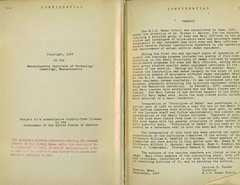|
|
||||
|
|
|
The cavity magnetron played a decisive role in WWII
|
|
|
|
|
In the summer of 1940, the war with Germany was at a critical stage.
France had recently surrendered and the Luftwaffe was engaged in a concerted bombing campaign against British cities.
The United Kingdom was being cut off from the Continent, and without allies to help her, she would soon be near the limit of her productive capacity - particularly in the all important field of electronics.
On the morning of 29 August, a small team of the country's top scientists and engineers, under the direction of Sir Henry Tizard and in conditions of absolute secrecy, was about to board a converted ocean liner.
With them they carried possibly the most precious cargo of the war - a black japanned metal deed box containing all of Britain's most valuable technological secrets.
They were on their way to America - to give them away.
This high-powered team included representatives from the Army, Navy and Air Force, along with specialists in the new technologies of war.
Earlier that morning, radar expert, Dr Edward "Taffy" Bowen - a vital member of this Tizard Mission and responsible for looking after the metal deed box that was to become known as "Tizard's briefcase" - almost lost it.
When he had arrived at London's Euston station, the Welshman had handed it to a porter while gathering up his remaining luggage, then watched helplessly as the man headed off to find the 0830 boat train to Liverpool without waiting for his customer.
As he struggled to keep the porter in sight above the wartime throngs, Eddie Bowen would not have drawn much attention from the busy Londoners. Only his face would have betrayed his concern.
Short distance
Just five days short of the war's first anniversary, Britain faced one of its most desperate hours.
The Battle of Britain was raging, and bombs were falling nightly on Liverpool. Nazi armies ringed the country from the Norwegian coast down to France; an invasion was expected within weeks.
As Bowen knew, the seemingly ordinary solicitor's deed box - for which he was personally responsible - held the power to change the course of the war.
Inside lay nothing less than all Britain's military secrets. There were blueprints and circuit diagrams for rockets, explosives, superchargers, gyroscopic gunsights, submarine detection devices, self-sealing fuel tanks, and even the germs of ideas that would lead to the jet engine and the atomic bomb.
But the greatest treasure of all was the prototype of a piece of hardware called a cavity magnetron, which had been invented a few months earlier by two scientists in Birmingham.
John Randall and Harry Boot had invented the cavity magnetron almost by accident.
It was a valve that could spit out pulses of microwave radio energy on a wavelength of 10cm. This was unheard of. Nothing like it had been invented before.
The wavelength for the radar system we were using at the start of the war was one-and-a-half metres. The equipment needed was bulky and the signals indistinct.
The cavity magnetron was to be the key that would allow us to develop airborne radar.
Kitchen technology
"It was a massive, massive breakthrough," says Andy Manning from the Radar Museum in Horning.
"It is deemed by many, even now, to be the most important invention that came out of the Second World War".
Professor of military history at the University of Victoria in British Columbia, David Zimmerman, agrees: "The magnetron remains the essential radio tube for shortwave radio signals of all types.
"It not only changed the course of the war by allowing us to develop airborne radar systems, it remains the key piece of technology that lies at the heart of your microwave oven today. The cavity magnetron's invention changed the world."
Because Britain had no money to develop the magnetron on a massive scale, Churchill had agreed that Sir Henry Tizard should offer the magnetron to the Americans in exchange for their financial and industrial help. No strings attached.
It was an extraordinary gesture. By September, the Massachusetts Institute of Technology had set up a secret laboratory; by November, the cavity magnetron was in mass production; and by early 1941, portable airborne radar had been developed and fitted to both American and British planes.
The course of the Second World War was about to be changed. It was, says writer Robert Buderi, possibly the most important development of the 20th Century.
In fact, it was so important a development that the official historian of the Office of Scientific Research and Development, James Phinney Baxter III, wrote: "When the members of the Tizard Mission brought the cavity magnetron to America in 1940, they carried the most valuable cargo ever brought to our shores."
The World in a Briefcase, made by Pier Productions, is on BBC Radio 4 on Monday 5 February at 2000 GMT. You will also be able to hear the programme on the Listen Again. The original cavity magnetron is held at the Science Museum in London service on the Radio 4 website


